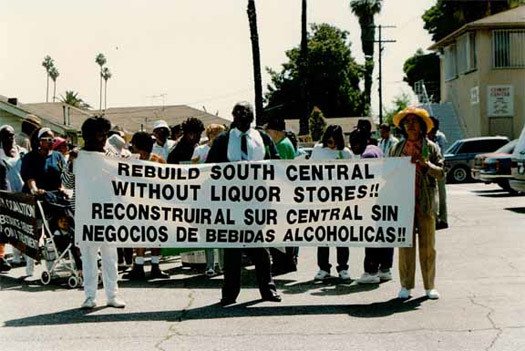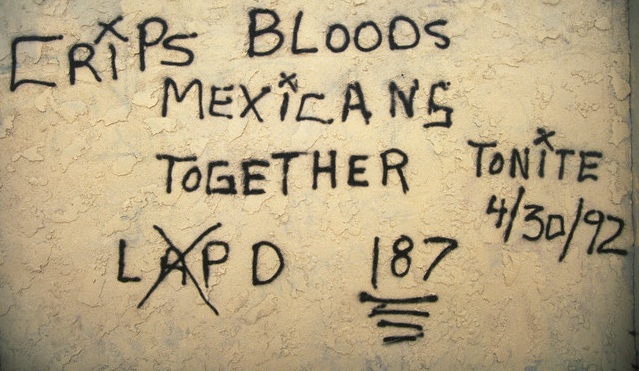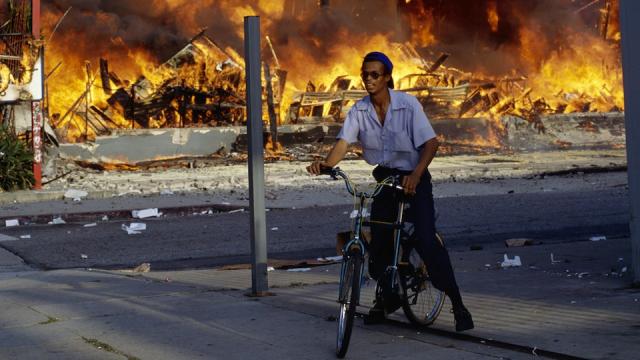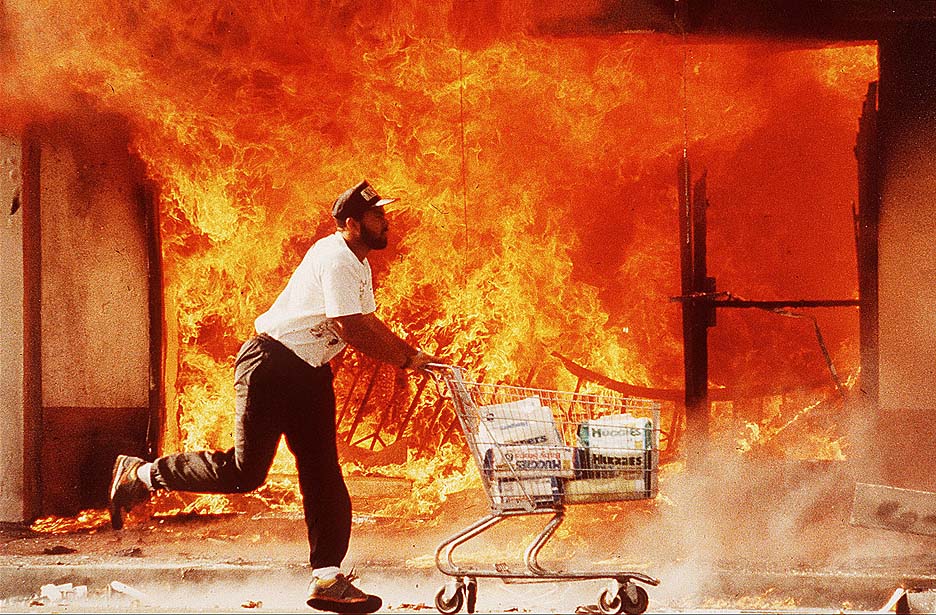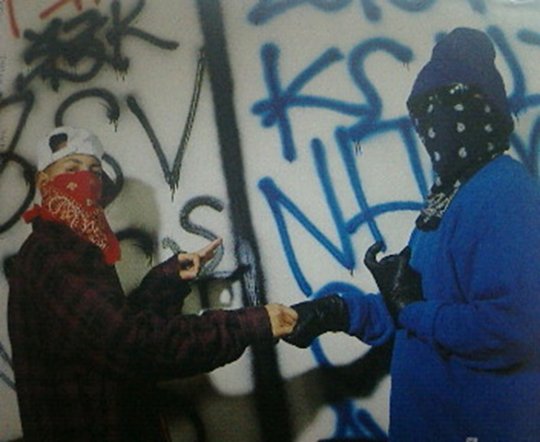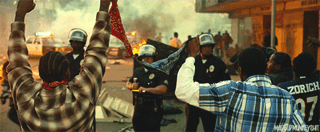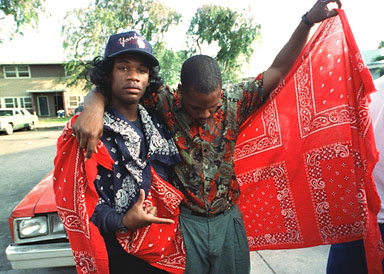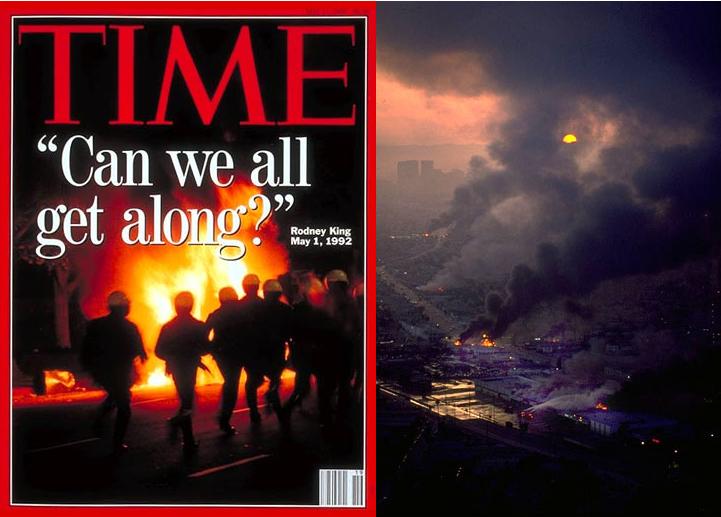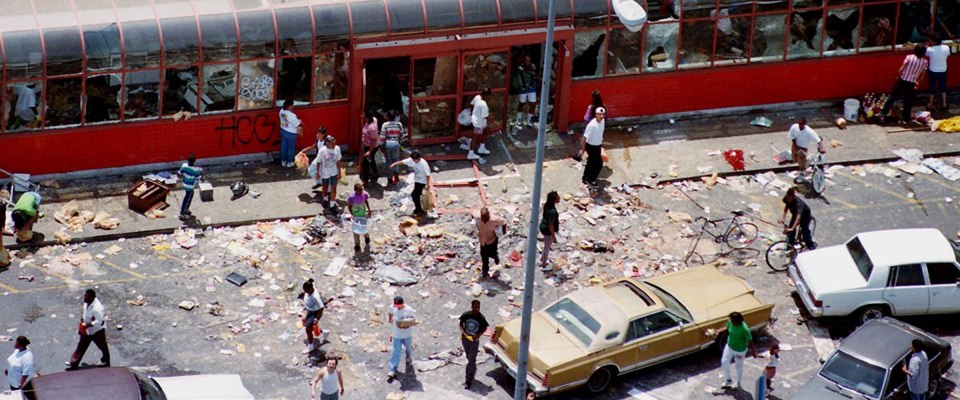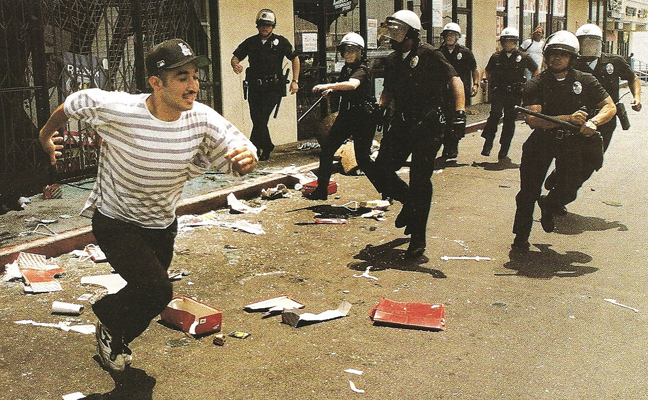Part 2 of 5 Part Series by Staff Writer Nunneh Nimley
Read Part 1 HERE
“They havin' church inside, but we facing the facts out here” ( 1993 film‘Birth Of Nation’)
The tension that had been in the air in the streets of Los Angeles for decades was within minutes of blowing up for the first time since the Watts Riots of 1965. The difference this time is the fact that this was in the middle of what can be referred to as the ‘Crack Generation’. Communities that once produced bright minds like Alprentice “Bunchy” Carter, and John Huggins, were once again channeling that revolutionary mind state. By now, those same streets were controlled, and in cases terrorized by the Blood and Crip street gangs.
The corner of Florence & Normandie was the first to feel the wrath of a community that’s been ignored for too long, it was time for them to get the attention of the world. Since no one was willing to listen, not only to this generation, but to leaders of the past, who had also spoken about the conditions of poor areas of LA, their actions would now become the topic of discussion for years to come. What started as a small group of neighborhood men, had swelled to hundreds. Blocking traffic, attacking motorists and breaking windows of cars passing through the intersection.
“What’s gonna happen tonight.. Is gonna happen tonight” (From VH-1 documentary, “LA Uprising”)
At the same time another group of citizens headed to the LAPD headquarters downtown. What ensued is something out of movies - officers rallied inside, but were clearly outnumbered. As rocks, and garbage cans begin to fly in the direction of the plated glass windows that extended throughout the exterior of the buildings structure. Residents wanted answers, and if they would not be given, it could gladly be taken in blood. Police were begged to come outside and face off with angry residents. Under strict orders they were to stand down until a further strategy could be formed to face something this generation of law enforcement had never witnessed on such a scale.
Officers dispatched to disturbances in the Florence area were also swarmed by citizens who too, wanted answers and had no desire to wait for another prepared statement from the chief of police, mayor, governor or George Bush (the president at the time). As the threat of danger increased, and due to the fact that the majority of officers were barricaded into their own building, officers were given strict orders to stand down, and exit the neighborhood. This was a small victory, in sorts but it showed through a common anger and frustration the community was able to do what they couldn’t through diplomacy. They were able to get the police the hell out the neighborhood if only for one night.
“You got people right now that’s sittin' in there talkin' about peace, every time we talk about peace we get a foot in our ass..' I’m not talkin' about peace NO MORE” (“Birth Of A Nation 4/29/92)
A revolutionary spirit that has always existed in L.A. was finally arising once again with its residents of all ages, both black and brown. Under-served communities erupted with energy. The youth blocked traffic with revenge on their minds. What the justice system represented then, and still represents now is just an extension of white supremacy, and the destruction of that structure was the plan of thousands of city’s youth by “Any Means Necessary". Be it good or bad, it wasn’t about appearance anymore. The police haven’t practiced ‘Non Violence’ when enforcing the law and the community, and now the community was going to face that brute force, with resistance.
Fires began to pop up on almost every corner. City residents were advised to avoid exiting the many city freeways that lead to the areas in and around where the uprisings were taking place. Korean shops were targeted in some cases, and the rift between the Black and Korean community could be traced directly to the case of Latasha Harlins, a 15 year-old who, after having an argument with Korean shop owner Soon Ja Du, was shot in the head as she exited the store. The surveillance video from the incident was shown on national news, and occurred 2 short weeks after the Rodney King beating. The sometimes hot and cold relationship between the Korean shop owners and Blacks was now burning up in flames. And as expected, Du’s store was set ablaze.
Immigrants who had their piece of the American Dream being burned to a crisp. An interesting dynamic in this is, it was the Black city residents, and community leaders that originally welcomed the Koreans not only to Los Angeles, but into the opportunity to gain the ownership of buildings and property in the L.A. area. It allowed them to get the necessary grants to make these corner stores, laundromats, dry cleaners, and liquor stores. Liquor stores some see as a tool for black genocide, “Why is there a liquor store on almost every corner in the black community? Because they want us to kill ourselves”, as Laurence Fishburne character (Furious Styles,) said in the 1991 classic, Boyz-N-Da Hood.
As usual though, it was America’s ignorance that blinded them from seeing such a reaction coming. Anyone with a pulse on the Black/Brown community knew the frustrations, they knew the hopelessness that existed. The tension was thick enough to cut with a knife, but it was once again not paid attention to. Had America been watching Boyz-N-Da Hood, or listening to Ice Cube, Ice T or NWA, they would’ve sensed the tone. Los Angeles was preparing for this moment since the days of COINTELPRO and the dissemination of Black empowerment groups like the L.A. Chapter of the Black Panther Party, and US Organization.
Those same political groups and remaining members, who weren’t murdered by the police and FBI were back on the streets and more or less back to where they started, poor youth in a society that was dedicated to keeping them in such dire conditions. So as you still have groups of men and women that were comrades, they began to do what they had learned in the Panthers in the years before, they started to organize. What has become the two most well known groups produced from this were, Community Revolutionary In Progress & Brotherly Love Overrides Oppressive Destruction, better known as the Bloods & Crips.
A gang war had raged at that point for the better part of 20 years. Claiming the lives of as many as 40,000 nationwide by that time. Neighborhoods had transformed into simply ‘hoods’, their were no more neighbors. This war turned brother against brother, cousins against cousin, solely based on the color of the bandana one wore, which was often times decided simply by what your street address was. Areas began to be carved out as either a Blood nationhood or a Crip neighborhood, venturing into one with something as simple as the wrong color could mean your life in some cases.
4 Years prior, on May 9th two teenage girls driving home from the store in a small red hatchback. The Eight Tray Crips, had been seeking revenge for being scammed during a cocaine deal. Unable to find the dealer involved, they had information that his sister was in the area driving a ref car, upon stopping next to the young ladies, they opened fire. Over one hundred shots were fired, and when the smoke settled passenger Jamee Finney (13), and Latonjyia Stover, (18) died at the scene. 6 suspects were arrested, and eventually sentenced to life in prison for the murders, which turned out to be an awful case of mistaken identity.
The war that ensued was fueled by the drug trade, specifically crack cocaine. The 80’s saw everything from kilos of coke to automatic weapons finding their way into streets. Landing in the hands of misguided youth, who witnessed social programs, and schools being closed. The gang became the family for those most hardly hit by the drug trade, those whose mothers were taken by addiction, fathers were taken by the prison system, found a new family in the many different Blood and Crip sets throughout Los Angeles county. As the community was bought out by those who didn’t reside there, kids who couldn’t find a job as teenagers, were often offered employment selling narcotics, and the protection of a gang. With a lack of options, its hard to blame them. When you’re hungry and someone offers you food, you’ll rarely ask where or how they got it, you simply ate. The Bloods and Crips became the only groups willing to accept those who society would not.
“Rodney King lit the match, now we’re burning” (Little Monster, 20/20 Coverage of Riots)
As the riots raged on for the first 48 hours the threat of Los Angeles turning into a 3 million man purge loomed. Opportunists used this uprising as a chance to take whatever they wanted, from food and other bare necessities at the supermarket to VCRs, TVs’ and other stereo equipment. Officials wondered what role the Bloods & Crips would play. The media made it seem as if they were the ones looting, and burning down business, but on a larger scale, we now know that was not the case. The threat of an already raging gang war, turning the entire county into its battle grounds, was high and seemed quite likely at this point.
“Take off the red, and take off the blue” (1993 “Birth Of a Nation 4/29/93)
But something strange happened, in the midst of the largest uprising in the history of the United States, the two organizations that had terrorized the streets of South Los Angeles decided this was a time to come together. The years of fighting had met its end, it was now time to unite. OGs from different Blood & Crip sets decided what was being faced was much bigger than what color rag you wore, it was a problem that was targeting black men. It became time to set differences aside, and with the help of the Nation Of Islam, a gang treaty was agreed upon for the betterment of the race.
Guys who the week before were trying to kill one another were now dancing to Ice Cube together. Trading bandanas the way soccer stars trade jerseys after a spirited match. It was a beautiful moment in the history of LA’s gang conflict, the guys the police thought would be the end of civilization as they knew it, became the symbol of change that the justice system refused to be. Past conflicts were swept under the rug, the warring projects of the Watts section of the city, Jordan Downs, Nickerson Gardens, etc. were instrumental in influencing their fellow sets from the surrounding sections of South Central LA to follow suit.
As expected though, the police chief was quick to downplay the “truce”, it was claimed by the LAPD that the treaty was nothing more than a partnership with the Bloods, Crips, and The Nation Of Islam to start an all out war with the police department. Alleged evidence of an attack on the police precinct prompted the LAPD to write a letter to the Associated Press and FBI about the alleged threat. The news like much of what was going on in LA at the time would be announced on a CBS World News broadcast, by head anchor Dan Rather. It was once again the police and FBI using COINTELPRO to derail and peaceful efforts between black organizations.
“This is Blood & Crip.. This is BLACK” (from the film, “The Bastards Of The Party)
Even as gang members attempted to dispel rumors that the truce was a guise, the propaganda train was already spreading and doors that were promised to be open to them if they were able to form some type of agreement to end gang warfare began to shut. Community programs in the area the gangs operated, the few that were left after the presidencies of Reagan & Bush refused to get involved, because of the threat of losing further funding. Even the First AME Church declined to allow Cle ‘Bone’ Sloan (Athens Parks Bloods), and Kersuan ‘Little Monster’ Scott (the One Eight-Tray Crips) into its doors as part of an interview with 20/20. So instead, the interview was conducted in the back alley, behind ’house of GOD’, once again, even when doing what was asked of them by the community for years. They had come together only to have the same results as beforehand.
Not to be discouraged, the gang members used the truce to form friendships, some that would last for years. The Nation Of Islam still supported, and even political figures like Jesse Jackson, California congresswoman Maxine Waters were supportive. In retrospect, the threat of a gang war against the police on a physical level was not the fear, their real fear was if the Bloods and Crips came together what that would mean to their job security? What would that mean for their department and its expansion? What would it mean to the courts that were prosecuting these young men, and the prisons they were housed in? In the mid 80s to the mid 90s, California had built and opened nearly 10 new correctional facilities, all of that would not have been necessary if not for crack’s invention, the Bloods and Crips.
At the time, Los Angeles city limits was home of hospitals with the best bullet wound specialists in the country, gangbanging and the easy access to automatic weapons created that. Now the possibility of that ending left the city’s official in panic. There are thousands of jobs, not only in law enforcement that depend on the continuation of gang conflict. The idea of that coming to an end would leave many without jobs and careers, the ramifications could have put a huge dent in the city’s budget. Just think, as a member of law enforcement, someone who’s sworn to serve and protect the taxpayers of a section of a municipality, why would the idea of those residents making peace worry you and your superiors? Law enforcement should have welcomed a truce, and offered funding of its own to make sure it was sustained.
That didn’t happen, what did happen was a bit more sinister. Members of both the Bloods and Crips have made claims that they were arrested, and after being sent to the county jail, their vehicles were being used by law enforcement to pull what could be viewed as “drive by” shootings before being impounded. All of this to keep the gang war going, to keep federal funding for police and prisons. It’s an old tactic that was used during the Black Power movement, and now here it is being used once again with street gangs.
The country watched as trucker Reginald Denney approached the corners of Florence and Normandie in his 18 wheeler, whether or not he was aware of what was happening is unclear, what is clear, is what happened next. He was snatched out of his car by a group of men and pummeled. Beaten to a bloody pulp, the most famous blow however was not from a fist or even the sole of a pair of Nike‘s. While he attempted to get up from the first part of his beating, he was hit in his right temple by a brick, thrown by Damian "Football" Williams, who did a victory dance and even pointed at the helicopter above that was filming the entire beating. Bob Tur voiced his disgust with the act, watching at home, fellow truck driver Bobby Green, saw the beating live, since he lived a few blocks way he made his way the site of the attack and along with the help of others, got Denny to safety.
Those beating Denny were dubbed “The L.A. Four” by the news media, the four men Williams, Henry Watson, Antoine Miller and Gary Williams. Eventually upon further investigation of the filmed beating, and with the help of residents who saw the attack as being uncalled for, cooperating witnesses helped authorities identify two additional men, Anthony Brown and Lance Parker, and they too were also charged with the attack. They would later be tried, which resulted in a plea deal for Watson who served 18 months awaiting trail and was given time served and released, all but Williams (who threw the brick) were freed due to the jury being unable to come to a verdict. Williams would later be sentenced to 10 years in prison.
“Can’t We all just.. Get along” (Rodney King)
On the fourth day of the riots, the National Guard arrived in the city to help calm the storm. Tanks occupied the streets residents once walked down, curfews were set, and for the first time in 96 hours the streets were calming down, but the uprising was by no means over. The day the Guard arrived was also the day the man that was in the middle of all the tension finally appeared for the first time since the verdicts had been read. Rodney King held a press conference, advised by his lawyers to read a prepared statement, he opted to just speak from the heart. He addressed the residents of South Central, and asked if we could for once just set our differences aside, if not for us, for the betterment of the youth. While he may not get booked for many speaking engagements, what he said was honest and heartfelt, and regardless of its delivery, was true in a sense.
A peace rally of around 30,000 city residents was also taking place. People, while still angry about the verdicts and the conditions in which they lived just wanted things to calm down. The tension was too much, the threat of violence was too great in the streets. It was mostly the elders of the community responsible for organizing such efforts, the majority of the youth was still angry and not quite ready to stand down to the police or the National Guard. These are teenagers with unlimited access to weapons like AK-47s, weapons not even the National Guard had. If not for the elders and the gang truce, this uprising could’ve been much worse, for much longer, as hard as that is to imagine.
When the smoke cleared over 50 people had been killed, 14,000 were arrested, more than 3,500 buildings set ablaze resulting in an estimated $1 billion of property damage. In some cases, business owners received their insurance settlement money, and opted not to reopen business for risk of the next uprising. Gutted out burned buildings remained untouched in some cases for the years it would take for new developers to move into South Central and build. So the same problems that helped create the uprising remained. The lack of business gave little to no opportunity to gaining employment, the only employers not turning down applicants were the illegal professions of the under world.

